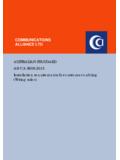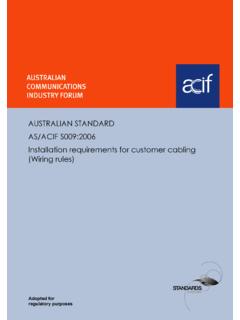Transcription of COMMUNICATIONS ALLIANCE LTD
1 COMMUNICATIONS ALLIANCE LTD INDUSTRY CODE C564:2011 MOBILE PHONE BASE STATION DEPLOYMENT Industry Code - Mobile Phone Base Station Deployment This Code was issued in draft form for public comment as DR C564:2011 First published as ACIF C564:2002 Second edition as ACIF C564:2002 Third edition as ACIF C564:2002 Fourth edition as ACIF C564:2004 Reprinted 30 March 2006 Fifth edition as C564:2011 COMMUNICATIONS ALLIANCE Ltd (formerly Australian COMMUNICATIONS Industry Forum Ltd) was formed in 2006 to provide a unified voice for the Australian COMMUNICATIONS industry and to lead it into the next generation of converging networks, technologies and services. Disclaimers 1) Notwithstanding anything contained in this Industry Code: a) COMMUNICATIONS ALLIANCE disclaims responsibility (including where COMMUNICATIONS ALLIANCE or any of its officers, employees, agents or contractors has been negligent) for any direct or indirect loss, damage, claim, or liability any person may incur as a result of any: i) reliance on or compliance with this Industry Code; ii) inaccuracy or inappropriateness of this Industry Code; or iii) inconsistency of this Industry Code with any law; and b) COMMUNICATIONS ALLIANCE disclaims responsibility (including where COMMUNICATIONS ALLIANCE or any of its officers, employees, agents or contractors has been negligent) for ensuring compliance by any person with this Industry Code.
2 2) The above disclaimers will not apply to the extent they are inconsistent with any relevant legislation. Copyright COMMUNICATIONS ALLIANCE Ltd 2011 This document is copyright and must not be used except as permitted below or under the Copyright Act 1968. You may reproduce and publish this document in whole or in part for your or your organisation s own personal or internal compliance, educational or non-commercial purposes. You must not alter or amend this document in any way. You must not reproduce or publish this document for commercial gain without the prior written consent of COMMUNICATIONS ALLIANCE . Organisations wishing to reproduce or publish this document for commercial gain ( for distribution to subscribers to an information service) may apply to subscribe to the COMMUNICATIONS ALLIANCE Publications Subscription Service by contacting the COMMUNICATIONS ALLIANCE Commercial Manager at If you publish any part of this document for any purpose, you must also publish this copyright notice as part of that i - C564:2011 COPYRIGHT DECEMBER 2011 INTRODUCTORY STATEMENT The Mobile Phone Base Station Deployment Industry Code (C564:2011) replaces the registered Deployment of Mobile Phone Network Infrastructure Industry Code (ACIF C564:2004).
3 The Mobile Phone Base Station Deployment Industry Code is designed to: allow the community and councils to have greater participation in decisions made by Carriers when deploying mobile phone base stations; and provide greater transparency to local community and councils when a Carrier is planning, selecting sites for, installing and operating Mobile Phone Radiocommunications Infrastructure. Although the Code cannot change the regulatory and legislative regime at local, State or Federal level, it can supplement the existing requirements already imposed on Carriers by requiring them to consult with the local community and to adopt a precautionary approach in planning, installing and operating Mobile Phone Radiocommunications Infrastructure. The attached Appendices which accompany the Code are designed to: aid in interpreting the Code; and supplement the Code.
4 In particular, Appendix J provides supporting information on the existing regulatory regime under which the Code operates. 2011 Revision A review of the Deployment of Mobile Phone Network Infrastructure Industry Code was undertaken five years after registration by the Australian COMMUNICATIONS Authority, April 2005. The 2011 Code revision has been undertaken following that review to clarify and provide certainty for all parties in the implementation of the Code. The purpose of the changes are to: require Carriers to develop and evolve the consultation plan for new proposals; improve transparency and visibility of the consultation process with local council and communities; increase the existing time allowed for local council and the community to comment on proposals for new infrastructure; incorporate new and revised methods of communicating with local councils and the community ( website, letters, signage); provide consistency, guidelines and examples of the type of letters, plans, signs and reports which Carriers will use when notifying and consulting with local council and the community.
5 Ensure that Carriers consider and have regard to public and school holidays and that appropriate extensions of time are provided for consultation during these periods; - ii - C564:2011 COPYRIGHT DECEMBER 2011 provide and update the RF EMR Health and Safety information, reports and signage in keeping with the current and relevant standards; update the Code as a COMMUNICATIONS ALLIANCE publication; and update the Code with further information on Land Access and Activity Notices (LAANs), Facilities Installation Permit, compensation and land owners rights. George Tzakis Chair WC29 : Mobile Phone Network Infrastructure Revision Working Committee December 2011 - 1 - C564:2011 COPYRIGHT DECEMBER 2011 TABLE OF CONTENTS 1 SCOPE AND OBJECTIVES 3 Scope 3 Objectives 4 Commencement and Application of Code 5 Relationship to Other Laws 5 Interpretation and Notification 5 Code Review 6 2 DEFINITIONS AND ABBREVIATIONS 7 3 GENERAL OBLIGATIONS ON CARRIERS 12 Telecommunications Network Forward Planning 12 4 APPLICATION OF THE PRECAUTIONARY APPROACH TO MOBILE PHONE RADIOCOMMUNICATIONS INFRASTRUCTURE PLACEMENT AND DESIGN 13 Site Selection 13 Mobile Phone Radiocommunications Infrastructure Design 14 5 LOW RF POWER Mobile Phone Radiocommunications INFRASTRUCTURE AND FIXED RADIO LINKS 16 Notification 16 6 CONSULTATION REQUIREMENTS FOR THE INSTALLATION AT A NEW SITE WITHOUT DEVELOPMENT APPLICATION 17 Application 17 Overview of Consultation
6 Process 17 Development and Evolution of Consultation Plan 18 Information about a proposal to be communicated 19 Timeframes 20 Engagement and Responsiveness 22 Assessing and Reporting on Outcomes 23 7 NOTIFICATION TO COUNCILS AND THE PUBLIC INSTALLATION AT AN EXISTING SITE WITHOUT DEVELOPMENT APPLICATION 25 Applicability 25 Council notification 25 Newspaper notification 26 Council and public submissions 26 8 APPLICATION OF PRECAUTIONARY APPROACH TO SITE OPERATION 27 Operation of infrastructure 27 Radiofrequency fields 27 Access and warning signs 27 Training 27 Out of service equipment 28 9 REQUIREMENT TO KEEP DOCUMENTARY EVIDENCE OF COMPLIANCE WITH PROCEDURES 29 - 2 - C564:2011 COPYRIGHT DECEMBER 2011 10 RADIO EMISSIONS AND HEALTH AND SAFETY INFORMATION 30 Requirement for Carriers to keep informed about EMR Research 30 RF EMR Health and Safety Information 30 Additional Information Supplied by Carrier 30 11 COMPLAINT HANDLING 32 Meaning of Complaint 32 Carrier to Develop Complaints Handling Procedure 32 Complaint Handling Procedure 32 12 REFERENCES 34 APPENDIX 35 A THE PRECAUTIONARY PRINCIPLE 35 B ADDITIONAL DESIGN INFORMATION 38 C ARPANSA EME REPORT FORMAT 39 D CONSULTATION GUIDELINES 43 E communication INFORMATION FORMATS 47 F BEST PRACTICE GUIDELINES FOR PLACEMENT OF SIGNS 52 G RF WARNING SIGNS 54 H GUIDELINES FOR QUALITY EMF RESEARCH 56 I EXTRACT FROM - RADIATION PROTECTION STANDARD 61 J BACKGROUND REGULATORY INFORMATION 64 PARTICIPANTS
7 69 - 3 - C564:2011 COPYRIGHT DECEMBER 2011 1 SCOPE AND OBJECTIVES Scope This Code applies to Carriers who are: (a) installing; (b) intending to install; (c) operating; or (d) contracting or arranging for the installation of fixed radiocommunications infrastructure, referred to as Mobile Phone Radiocommunications Infrastructure in this Code, which is used, intended to be used, or capable of being used to supply Public Mobile Telecommunications Services. This Code does not apply to Radiocommunications Infrastructure that is not Mobile Phone Radiocommunications Infrastructure. NOTE: This Code also covers the work of contractors or agents of Carriers, infrastructure lessors, infrastructure developers, telecommunications service providers and other entities engaged in activities covered by this Code on behalf of a Carrier.
8 NOTE: A Public Mobile Telecommunications Service is a publicly accessible mobile phone network, as distinct from a non-public network, for example, an Immediate Circle. However, this Code does not apply to Carriers in relation to the intended installation or operation of Exempt Mobile Phone Radiocommunications Infrastructure. NOTE: The following expressions are defined in clause 2: Exempt Mobile Phone Radiocommunications Infrastructure means: (a) Mobile Phone Radiocommunications Infrastructure installed at the request of the occupier to supply services exclusively to that property and not for re-transmission by radiocommunications to another property; or (b) Mobile Phone Radiocommunications Infrastructure used or intended to be used for the purpose of providing a facility for use by, or on behalf of, a defence organisation for defence purposes; or (c) Mobile Phone Radiocommunications Infrastructure used or intended to be used for the sole purpose of facilitating the provision of emergency services by emergency services organisations.
9 Or - 4 - C564:2011 COPYRIGHT DECEMBER 2011 (d) Temporary Mobile Phone Radiocommunications Infrastructure; or (e) Appendix I Equipment. Appendix I Equipment means fixed, mobile or portable radiocommunications equipment that is intended for operation by Carriers or non-Carriers, and which would otherwise meet the exemption from evaluation requirements set out in Appendix I. Example: Appendix I is intended to address low power devices such as a cordless phone which comprises a base unit and handset and would generally be exempt from evaluation under the 2002 ARPANSA Standard. Note: Appendix I Equipment applies to equipment that meets the exemptions in Appendix I. This applies whether the equipment is fixed, mobile or portable. Note: Appendix I is an extract from the Radiation Protection Standard Maximum Exposure Levels to Radiofrequency Fields 3 kHz to 300 GHz, published by the Australian Radiation Protection and Nuclear Safety Agency (ARPANSA) in 2002.
10 Emergency Service Organisation includes, but is not limited to: (a) police forces or services; (b) fire services (urban and rural); and (c) ambulance services. Immediate Circle has the same meaning as in the Act. NOTE: An Immediate Circle is a non-public network used within an organisation. For example, a council radio network used by council employees to communicate with each other, a taxi service network or a regional water authority network. Objectives The objectives of this Code are: (a) to apply a Precautionary Approach to the deployment of Mobile Phone Radiocommunications Infrastructure; (b) to provide best practice processes for demonstrating compliance with relevant exposure limits and the protection of the public; - 5 - C564:2011 COPYRIGHT DECEMBER 2011 (c) to ensure that the exposure of the community to EMR is minimised; (d) to ensure relevant stakeholders are informed, consulted and engaged with before Mobile Phone Radiocommunications Infrastructure is constructed; (e) to specify standards for consultation, information availability and presentation; (f) to consider the impact on the wellbeing of the community, physical or otherwise, of Mobile Phone Radiocommunications Infrastructure.








